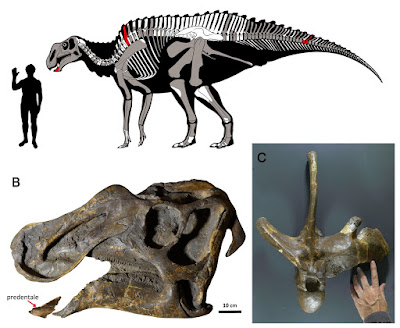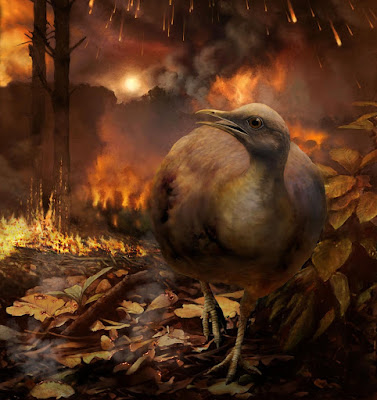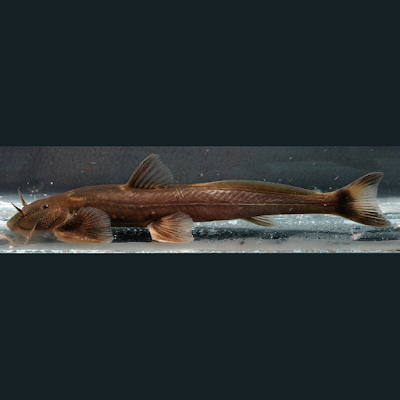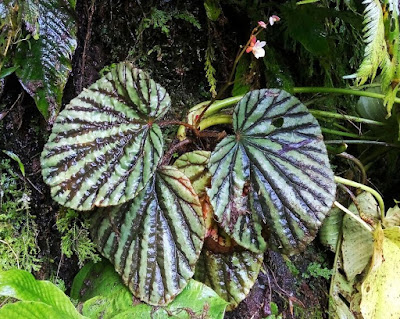[Most Recent Entries] [Calendar View]
Thursday, May 31st, 2018
| Time | Event | ||||
| 2:38p | [Paleontology • 2017] Redescription of A Remarkably Large Gryposaurus notabilis (Dinosauria: Hadrosauridae) from Alberta, Canada
Abstract MSNM V345 is a partial skeleton of the North American hadrosaur species Gryposaurus notabilis, Lambe 1914, dis-covered in 1922 in the Dinosaur Park Formation of Dinosaur Provincial Park, Alberta, Canada. It was shipped in several crates to the Museo di Storia Naturale di Milano (MSNM), Italy, where it arrived in October 1958. Careless transportation during its long journey to Milan meant that the skeleton arrived extremely damaged and required heavy restoration work by MSNM staff. A preliminary study of the specimen was conducted by Vittorio Vialli in 1960 while part of it was still under preparation. That study was followed by a more detailed, although still partial, osteological description by Giovanni Pinna in 1979. On the centennial of the species’ discovery, we decided to examine the specimen in even greater detail in order to improve knowledge on the dinosaur’s skeletal anatomy and help clarify the taxonomy of the genus. Here, we redescribe the dinosaur’s osteology, focusing on unpublished elements, such as metapodials, phalanges, sacral vertebrae, and some caudal vertebrae, recently discovered to be located at the MSNM. Isolated appendicular elements found at the same quarry and tentatively referable to other individuals of the same taxon or to other dinosaur species are also briefly mentioned. Histological analysis of a core obtained from the femur revealed that it was made of fibrolamellar bone with a high number of Haversian systems. The presence of an external fundamental system indicates that the individual was fully adult at the moment of death. Of note, the skeletal remains present with traces of at least four pathological conditions: a cavity in the predentary is speculated to be the result of osteomyelitis; the fifth dorsal vertebra is fused to the left rib through a overgrowth of bone, and is interpreted as osteosclerosis subsequent to a fracture; the neural spine of the 26th caudal vertebra is fractured and healed, and the centrum has a strap of bone growing up to the side of the preceding centrum, explainable as idiopathic skeletal hyperostosis. A review of the skeletal reconstructions of the genus is also presented, followed by a summary of the skin remains and remarks on other anatomical traits. Altogether, the new data obtained on MSNM V345 have allowed us to present a more accurate and up-to-date skeletal reconstruction and in vivo restoration of G. notabilis. Keywords: Hadrosauridae, Cretaceous, osteology, palaeopathology, anatomical illustration.
CONCLUSIONS: Specimen MSNM V345 is a large, robust individual of Gryposaurus notabilis. Our re-examination of all its bones housed at the MSNM has allowed us to revise previous estimates on the completeness of the skeleton, which now reaches 32.68% (39.54% when taking into account the hid-den cranial bones, and 48.37% when duplicating existing counterlateral elements). The skull of MSNM V345 is one of the largest known for Gryposaurus. Our recalculation of the size of the skeleton, which takes into account the spaces occupied in vivo by intervertebral and epiphyseal cartilage, gives us an overall length of 800 cm in a neutral pose and a height at the hip of 315 cm. The osteology of the individual shows features related to other G. notabilis specimens: a dorsoventrally narrow orbit, infratemporal fenestra twice higher than wide, a well-developed nasal arch, wide and irregular ventral embayment of the jugal, a long and narrow quadratojugal, a predentary with nine large denticles placed asymmetrically, and a tall neural spine on the second caudal vertebra. The advanced ontogenetic age of the skeleton – which likely belonged to a senile individual – is corroborated by palaeohistological analysis showing the presence of EFSs and several generations of Haversian systems in a femur, indicative of a specimen that was fully adult at time of death. Finally, this individual was affected by several skele-tal disorders. The predentary bears a large, central fora-men located in the caudomedian plane of the bone. The histology of this anomaly reveals the presence of large resorption cavities and a randomised pattern of osteocytes, indicators of osteomyelitis. The transverse process of dorsal vertebra 5 is fused with the proximal region of the rib, affected by an abnormal overgrowth of bone tissue. CT-scanning of this vertebra indicates hyper-trophied osteosclerosis likely consequent to traumatic fracture. The caudal vertebrae 25 and 26 had their cen-tra fused together, with that of vertebra 25 broken into two halves. CT-scanning indicates that this condition might represent skeletal hyperostosis or haemangioma. Gryposaurus notabilis is one of the first hadrosaurs depicted for the general audience. Nevertheless, it is not as popular as other duck-billed dinosaurs, such as Edmontosaurus, Parasaurolophus, or Corythosaurus. We have proposed new skeletal and in vivo restorations using the anatomical data obtained from our analysis. Filippo Bertozzo, Cristiano Dal Sasso, Matteo Fabbri, Fabio Manucci and Simone Maganuco. 2017. Redescription of A Remarkably Large Gryposaurus notabilis (Dinosauria: Hadrosauridae) from Alberta, Canada. Memorie della Società Italiana di Scienze Naturali e del Museo Civico di Storia Naturale di Milano. 43. scienzafacile.it/2018/02/24/alla-riscope facebook.com/notes/paleontologia-e-paleo | ||||
| 4:20p | [Paleontology • 2018] Early Evolution of Modern Birds Structured by Global Forest Collapse at the End-Cretaceous Mass Extinction
Highlights • The end-Cretaceous mass extinction devastated forest habitats globally • Tree-dwelling birds failed to persist across the end-Cretaceous extinction event • All bird groups that survived the end-Cretaceous extinction were non-arboreal • The early ancestors of many modern tree-dwelling bird groups were ground-dwelling Summary The fossil record and recent molecular phylogenies support an extraordinary early-Cenozoic radiation of crown birds (Neornithes) after the Cretaceous-Paleogene (K-Pg) mass extinction. However, questions remain regarding the mechanisms underlying the survival of the deepest lineages within crown birds across the K-Pg boundary, particularly since this global catastrophe eliminated even the closest stem-group relatives of Neornithes. Here, ancestral state reconstructions of neornithine ecology reveal a strong bias toward taxa exhibiting predominantly non-arboreal lifestyles across the K-Pg, with multiple convergent transitions toward predominantly arboreal ecologies later in the Paleocene and Eocene. By contrast, ecomorphological inferences indicate predominantly arboreal lifestyles among enantiornithines, the most diverse and widespread Mesozoic avialans. Global paleobotanical and palynological data show that the K-Pg Chicxulub impact triggered widespread destruction of forests. We suggest that ecological filtering due to the temporary loss of significant plant cover across the K-Pg boundary selected against any flying dinosaurs (Avialae) committed to arboreal ecologies, resulting in a predominantly non-arboreal post-extinction neornithine avifauna composed of total-clade Palaeognathae, Galloanserae, and terrestrial total-clade Neoaves that rapidly diversified into the broad range of avian ecologies familiar today. The explanation proposed here provides a unifying hypothesis for the K-Pg-associated mass extinction of arboreal stem birds, as well as for the post-K-Pg radiation of arboreal crown birds. It also provides a baseline hypothesis to be further refined pending the discovery of additional neornithine fossils from the Latest Cretaceous and earliest Paleogene. Daniel J. Field, Antoine Bercovici, Jacob S. Berv, Regan Dunn, David E. Fastovsky, Tyler R. Lyson, Vivi Vajda and Jacques A. Gauthier. 2018. Early Evolution of Modern Birds Structured by Global Forest Collapse at the End-Cretaceous Mass Extinction. Current Biology. In Press. DOI: 10.1016/j.cub.2018.04.062 What the asteroid that wiped out dinosaurs meant for birds eurekalert.org/e/8gbw via @CellPressNews @EurekAlert When the dinosaurs died, so did forests—and tree-dwelling birds phys.org/news/2018-05-dinosaurs-died-for | ||||
| 4:22p | [Ichthyology • 2018] Exostoma ericinum • A New Glyptosternine Catfish (Siluriformes: Sisoridae) from southwestern China
Abstract A new species of glyptosternine catfish in the genus Exostoma is described in this study. The new species, Exostoma ericinum, is known from the upper Dayingjiang (=Taping River) drainage in southwestern China and is distinguished from congeners in having an unique combination of the following characters: 42–44 vertebrae; parallel striae on anterolateral surfaces of lips and lower surface of maxillary barbel; interorbital distance 26–31% HL; preanal length 67.7–70.5% SL; body depth at anus 10.4–12.0% SL (1.4–1.9 times in caudal peduncle depth); length of adipose-fin base 39.5–43.0% SL; lacking an incision at posterior extremity of adipose-fin base; caudal peduncle length 23.2–26.2% SL; caudal peduncle depth 5.7–7.9% SL; and caudal-fin lobes with slightly concave posterior margin.
Heok Hee Ng. 2018. Exostoma ericinum, A New Glyptosternine Catfish from southwestern China (Teleostei: Siluriformes: Sisoridae). Zootaxa. 4420(3); 405-414. DOI: 10.11646/zootaxa.4420.3.6 | ||||
| 4:30p | [Botany • 2018] Taxonomic Status of Begonia promethea (sect. Petermannia, Begoniaceae) in Borneo
Abstract The rediscovery of Begonia promethea Ridl. for the first time since its description in 1906 led to the discovery that the later described B. beccarii Warb. is synonymous with it and that it belongs in Begonia sect. Petermannia. It is a rare, endangered species known only from three localities, two locations from the Kuching Division, Sarawak, Malaysia and another one from West Kalimantan, Indonesia. A detailed, illustrated description and a distribution map of Begonia promethea are provided. We suggest an IUCN conservation category of EN B2ab(iii). Lectotypes for both names are designated. Keywords. Begonia beccarii, conservation, Sarawak, taxonomy
Begonia promethea Ridl., J. Straits Branch Roy. Asiat. Soc. 46: 259 (1906). – TYPE: Borneo, Sarawak, Bau District, Buso, Bukit Tundong, September 1903, ... Begonia beccarii Warb., syn. nov., ... .... Etymology. The meaning of the specific epithet is obscure. Prometheus was the Greek god who fashioned clay to create the first people, and who was chained to a rock to have his liver pecked out by an eagle for all eternity as a punishment for stealing fire from the gods and giving it to humanity. Ridley gives no hint as to the connection between him and this begonia, but we speculate it may be due to the isolated sandstone rocks on which the species grows, where Ridley noted he ‘could reach but few plants of it’. R. Kiew, S. Julia, C.Y. Ling, A. Randi, D. Girmansyah and M. Hughes. 2018. Taxonomic Status of Begonia promethea (sect. Petermannia, Begoniaceae) in Borneo. Gardens' Bulletin Singapore. 70(1); 155–161. |
| << Previous Day |
2018/05/31 [Calendar] |
Next Day >> |














